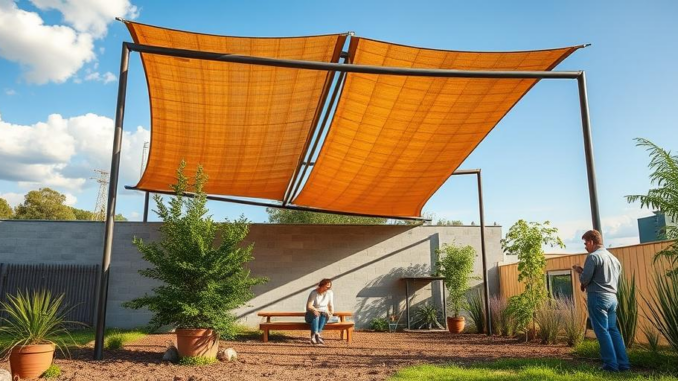
Summary
Maximize BREEAM credits with strategic shading solutions. This article provides actionable steps to optimize shading for enhanced energy efficiency, improved occupant well-being, and innovation points. Learn how to integrate shading seamlessly into your building design for a more sustainable and comfortable environment.
Discover how Focus360 Energy can help with BREEAM certification.
** Main Story**
Okay, so you’re aiming for BREEAM certification? It’s becoming increasingly important, isn’t it? Shading solutions can be a real game-changer for boosting your score, and honestly, they’re often overlooked. Let’s break down how to make the most of them; it’s a little more involved than just slapping on some blinds.
The Early Bird Gets the BREEAM Credit
The absolute first thing you need to do is get shading integrated right from the start. I mean, day one. Talk to a BREEAM assessor or an accredited pro—someone who really knows their stuff—as soon as you can. It’s a small investment that can save you a lot of headaches (and money) later. Why? Because it lets you ensure everything works together seamlessly. You don’t want to realize halfway through the project that your beautiful shading system is messing with your ventilation strategy, do you? Set clear, measurable goals aligned with BREEAM criteria to maximize your potential score. It’s like aiming for a bullseye instead of just throwing darts at the wall.
Climate is Key
This might sound obvious, but you’d be surprised how many people mess this up. You can’t just use the same shading design for a building in Dubai as you would for one in London! You have to tailor your approach to your specific climate.
Analyze those sun paths! Check the prevailing weather conditions, solar orientation, latitude, altitude… the whole nine yards. Use climate modeling software—it’s worth the investment—to predict how your shading will perform and optimize energy efficiency. I remember one project where we thought we’d nailed the shading design, but the climate modeling revealed a serious issue with glare at a specific time of day. We were able to fix it before construction even started, saving us a ton of money and preventing some serious occupant discomfort.
Energy Efficiency: The Obvious Win
Effective shading is a direct route to better energy performance, no question. After all, you’re trying to minimize solar heat gain, which means less reliance on those energy-hogging HVAC systems. Shading improves the building envelope performance and lowers energy consumption. Win-win.
Consider automated shading systems, too. Integrating them with your building management system (BMS) gives you dynamic control and even more optimized energy savings. Think of it as smart shading that adapts to the weather conditions and building occupancy in real time. It’s a bit more upfront cost, but the long-term savings are pretty significant.
Happy Occupants, Happy BREEAM Assessor
It’s not just about energy, though, is it? You want to maximize natural daylight while minimizing glare and discomfort. It’s a delicate balance. Design shading systems that do exactly that! And here’s a pro tip: give occupants some control over their shading devices. Let them personalize their comfort. Creating a comfortable and productive indoor environment boosts well-being, and that’s something BREEAM definitely rewards.
Material Matters (A Lot)
Think about the materials you’re using for your shading systems. Are they durable? Are they recyclable? Do they have low embodied carbon? These are all important questions. Select materials with minimal environmental impact. That said, don’t be afraid to explore innovative shading technologies and designs for potential innovation credits.
Bioclimatic design principles are worth investigating, too. Can you integrate nature-based shading solutions, like trees or green walls? It’s a nice touch that adds both visual appeal and environmental benefits.
Keep it Dark (In the Right Ways)
Light pollution is a surprisingly big deal, and shading can help. Implement solutions that control exterior lighting and minimize disruption to surrounding ecosystems. Comply with local light pollution regulations—it’s the responsible thing to do, and it helps get that BREEAM tick. I actually read an article recently where a city was attempting to get a ‘dark sky’ designation so it definitely is a hot topic.
Documentation is Your Friend
You need to document everything. I mean, really document it. Shading strategies need to be documented throughout the design and construction phases, from material selection to performance calculations and integration with other building systems. You’re building a case, basically. So prepare a comprehensive report demonstrating compliance with BREEAM criteria. It’s a pain, I know, but trust me, it’s worth the effort.
Get By With a Little Help From Your Friends
Don’t be afraid to ask for help. Consult with experienced shading specialists and BREEAM assessors. I find they often have a better understanding of the process and can help avoid crucial mistakes. Engage with industry professionals for guidance on optimizing your shading strategies. Collaborate with manufacturers and suppliers to explore innovative shading solutions and technologies. You don’t have to do this alone. It’s really a collaboration, and when it’s done right, the results can be pretty impressive. So, with a little help, you can effectively leverage shading solutions to achieve a higher BREEAM rating. Shading offers a multifaceted approach to sustainable building design, enhancing energy efficiency, improving occupant comfort, and demonstrating innovation. Embrace these strategies to create environmentally responsible and high-performing buildings that benefit both occupants and the planet. That said, BREEAM standards and regulations are subject to change and you should stay up-to-date with the latest requirements for your specific project.


So, light pollution’s a big deal, huh? I never thought my late-night reading habit was a threat to the cosmos. Maybe I should invest in some blackout curtains and a dimmer switch to save the planet, one chapter at a time.
That’s a great point! Small changes can make a big difference. Even reducing light spillage from our homes can collectively help reduce light pollution and protect our night skies. Blackout curtains and dimmer switches are excellent first steps! Let’s all read responsibly!
Editor: FocusNews.Uk
Thank you to our Sponsor Focus 360 Energy